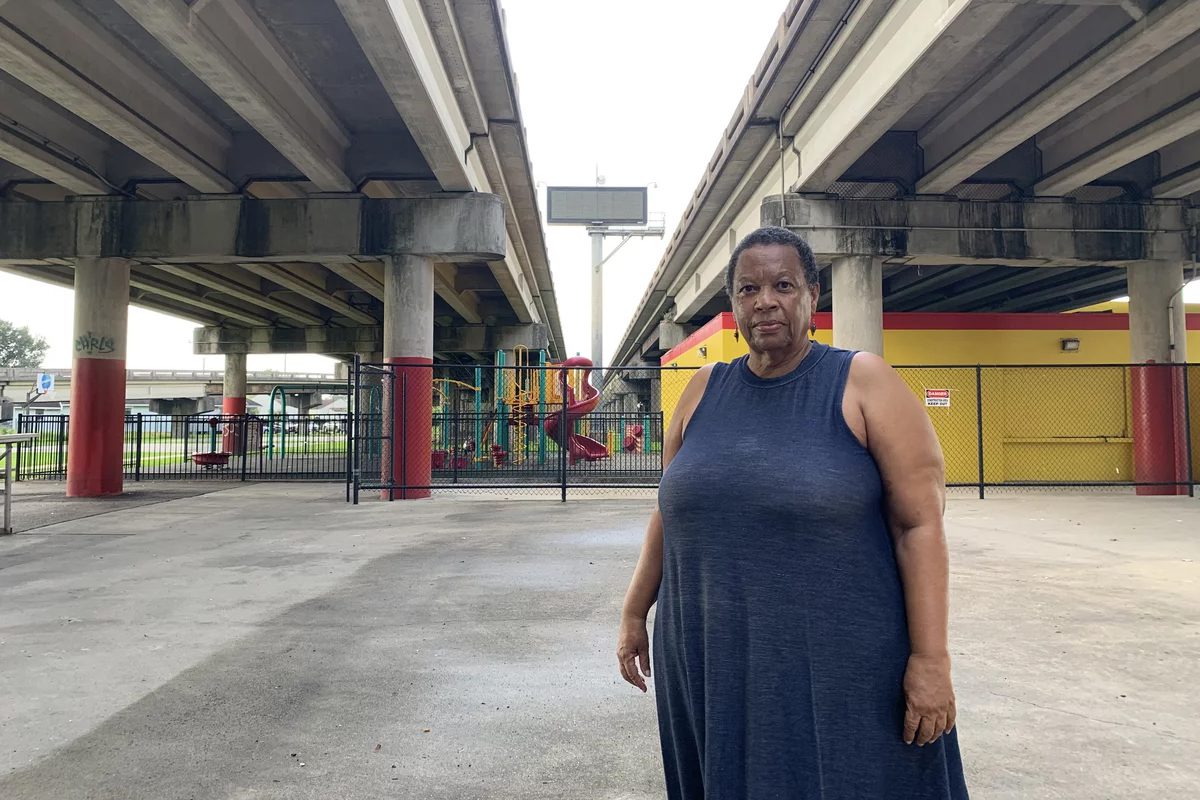Aside from a few discarded hypodermic needles on the ground, the Hunter’s Field Playground in New Orleans looks almost untouched. It’s been open more than nine years, but the brightly painted red and yellow slides and monkey bars are still sleek and shiny, and the padded rubber tiles feel springy underfoot.
For people who live nearby, it’s no mystery why the equipment is in relatively pristine shape: Children don’t come here to play.
“Because kids are smart,” explained Amy Stelly, an artist and urban designer who lives about a block away on Dumaine Street. “It’s the adults who aren’t. It’s the adults who built the playground under the interstate.”
Hunter’s Field is wedged directly beneath the elevated roadbeds of the Claiborne Expressway section of Interstate 10 in the city’s 7th Ward.
There are no sounds of laughter or children playing. The constant cuh-clunk, cuh-clunk of the traffic passing overhead makes it difficult to hold a conversation with someone standing next to you. An average of 115,000 vehicles a day use the overpass, according to a 2012 study.
“I have never seen a child play here,” Stelly said.
Amy Stelly, an artist, urban designer, and community activist, stands beneath the Claiborne Expressway on July 18. Stelly, who lives nearby, is working with Louisiana State University on an Environmental Protection Agency study of the noise and air pollution from the highway, and still supports moving this stretch of Interstate 10 away from the historically Black community.(Drew Hawkins/Gulf States Newsroom)
Stelly keeps a sharp eye on this area as part of her advocacy work with the Claiborne Avenue Alliance, a group of resi …
Article Attribution | Read More at Article Source
Aside from a few discarded hypodermic needles on the ground, the Hunter’s Field Playground in New Orleans looks almost untouched. It’s been open more than nine years, but the brightly painted red and yellow slides and monkey bars are still sleek and shiny, and the padded rubber tiles feel springy underfoot.
For people who live nearby, it’s no mystery why the equipment is in relatively pristine shape: Children don’t come here to play.
“Because kids are smart,” explained Amy Stelly, an artist and urban designer who lives about a block away on Dumaine Street. “It’s the adults who aren’t. It’s the adults who built the playground under the interstate.”
Hunter’s Field is wedged directly beneath the elevated roadbeds of the Claiborne Expressway section of Interstate 10 in the city’s 7th Ward.
There are no sounds of laughter or children playing. The constant cuh-clunk, cuh-clunk of the traffic passing overhead makes it difficult to hold a conversation with someone standing next to you. An average of 115,000 vehicles a day use the overpass, according to a 2012 study.
“I have never seen a child play here,” Stelly said.
Amy Stelly, an artist, urban designer, and community activist, stands beneath the Claiborne Expressway on July 18. Stelly, who lives nearby, is working with Louisiana State University on an Environmental Protection Agency study of the noise and air pollution from the highway, and still supports moving this stretch of Interstate 10 away from the historically Black community.(Drew Hawkins/Gulf States Newsroom)
Stelly keeps a sharp eye on this area as part of her advocacy work with the Claiborne Avenue Alliance, a group of resi …nnDiscussion:nn” ai_name=”RocketNews AI: ” start_sentence=”Can I tell you more about this article?” text_input_placeholder=”Type ‘Yes'”]

